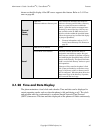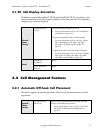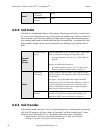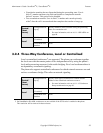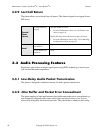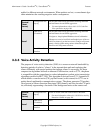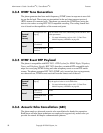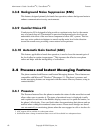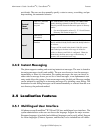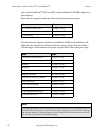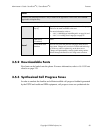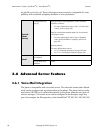
Administrator’s Guide - SoundPoint
®
IP / SoundStation
®
IP Features
Copyright © 2006 Polycom, Inc. 57
urable for different network environments. When packets are lost, a concealment algo-
rithm minimizes the resulting negative audio consequences.
3.3.3 Voice Activity Detection
The purpose of voice activity detection (VAD) is to conserve network bandwidth by
detecting periods of relative “silence” in the transmit data path and replacing that
silence efficiently with special packets that indicate silence is occurring. For those
compression algorithms without an inherent VAD function, such as G.711, the phone
is compatible with the comprehensive codec-independent comfort noise transmission
algorithm specified in RFC 3389. This algorithm is derived from G.711 Appendix II,
which defines a comfort noise (CN) payload format (or bit-stream) for G.711 use in
packet-based, multimedia communication systems. The phone generates CN packets
(also known as Silence Insertion Descriptor (SID) frames) and also decodes CN pack-
ets, efficiently regenerating a facsimile of the background noise at the remote end.
Central
(boot
server)
Configuration file:
sip.cfg
Set the jitter buffer tuning parameters including minimum
and maximum size and shrink aggression.
• For more information, refer to 4.6.1.8.1.2 Codec Pro-
files <profiles/> on page 109.
Local
Web Server
(if enabled)
Set the jitter buffer tuning parameters including minimum
and maximum size and shrink aggression.
Navigate to: http://<phoneIPAddress>/coreConf.htm#au
Changes are saved to local flash and backed up to <Ethernet
address>-phone.cfg on the boot server. Changes will perma-
nently override global settings unless deleted through the
Reset Local Config menu selection.
Local Phone User
Interface
None.
Central
(boot
server)
Configuration file:
sip.cfg
Enable or disable VAD and set the detection threshold.
• For more information, refer to 4.6.1.8.10 Voice Activity
Detection <VAD/> on page 118.
Local
Web Server
(if enabled)
None.
Local Phone User
Interface
None.



